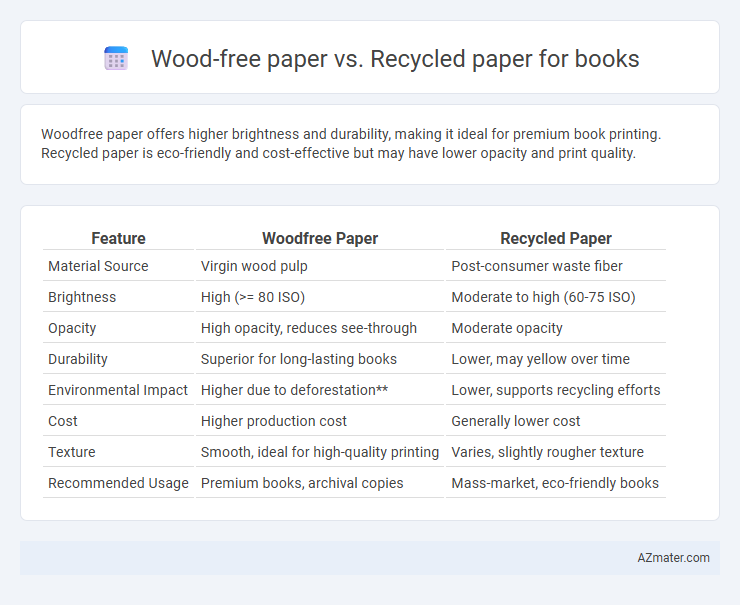Woodfree paper offers higher brightness and durability, making it ideal for premium book printing. Recycled paper is eco-friendly and cost-effective but may have lower opacity and print quality.
Table of Comparison
| Feature | Woodfree Paper | Recycled Paper |
|---|---|---|
| Material Source | Virgin wood pulp | Post-consumer waste fiber |
| Brightness | High (>= 80 ISO) | Moderate to high (60-75 ISO) |
| Opacity | High opacity, reduces see-through | Moderate opacity |
| Durability | Superior for long-lasting books | Lower, may yellow over time |
| Environmental Impact | Higher due to deforestation | Lower, supports recycling efforts |
| Cost | Higher production cost | Generally lower cost |
| Texture | Smooth, ideal for high-quality printing | Varies, slightly rougher texture |
| Recommended Usage | Premium books, archival copies | Mass-market, eco-friendly books |
Introduction to Book Paper Types
Woodfree paper, commonly used in book printing, is made from chemically processed pulp that removes lignin, resulting in a smooth, bright surface ideal for high-quality text and images. Recycled paper, created from recovered fibers, offers an eco-friendly alternative with varying degrees of brightness and texture depending on the processing method. Both woodfree and recycled papers impact the book's durability, print clarity, and environmental footprint, making the choice crucial for publishers balancing quality and sustainability.
What is Woodfree Paper?
Woodfree paper is a high-quality paper made from chemical pulp that is free of lignin, providing enhanced durability and brightness ideal for book printing. Unlike recycled paper, which contains fibers reclaimed from used paper products, woodfree paper offers a smoother surface and better print clarity, ensuring sharp text and vivid images. Its superior acid-free composition helps prevent yellowing and preserves the longevity of printed books.
What is Recycled Paper?
Recycled paper is produced from recovered paper materials that have been reprocessed to create new sheets, reducing the demand for virgin pulp and minimizing environmental impact. Unlike woodfree paper, which is derived directly from virgin fibers without mechanical pulp, recycled paper often contains a mix of post-consumer and pre-consumer waste, contributing to sustainability in book production. The use of recycled paper supports forest conservation by lowering deforestation rates and decreasing energy consumption during manufacturing.
Manufacturing Process Comparison
Woodfree paper is produced primarily from chemical pulp that removes lignin, resulting in a smoother, brighter, and more durable paper ideal for high-quality books. Recycled paper manufacturing involves reprocessing used paper fibers, which often requires additional cleaning and deinking steps to remove inks and contaminants, leading to a slightly lower fiber quality and less brightness. The woodfree process involves chemical pulping that enhances cellulose purity, whereas recycled paper manufacturing emphasizes fiber reuse and environmental conservation through energy-efficient and waste-reducing techniques.
Environmental Impact: Woodfree vs Recycled
Recycled paper significantly reduces deforestation and conserves natural resources by utilizing post-consumer waste, lowering the demand for virgin wood fibers in book production. Woodfree paper, while offering higher brightness and strength, relies on virgin fibers, contributing to increased carbon emissions and habitat loss. Choosing recycled paper for books supports sustainable forestry practices and decreases landfill waste, enhancing overall environmental benefits.
Print Quality and Performance
Woodfree paper offers superior print quality with a smoother surface and enhanced opacity, resulting in sharper text and vibrant images ideal for high-end book printing. Recycled paper tends to have a slightly rougher texture and lower brightness, which can affect color accuracy and overall print sharpness but improves environmental sustainability. Performance-wise, woodfree paper is more durable and less prone to yellowing, ensuring longevity, while recycled paper may exhibit faster wear but supports circular economy goals.
Durability and Longevity
Woodfree paper, made from chemically processed wood pulp, offers superior durability and resistance to yellowing, ensuring books maintain their quality over decades. Recycled paper, often containing shorter fibers and previous print residues, tends to be less durable and can degrade faster under frequent handling or poor storage conditions. For long-lasting books, woodfree paper remains the preferred choice due to its enhanced longevity and strength characteristics.
Cost Analysis
Woodfree paper generally incurs higher production costs due to the use of virgin fibers and extensive processing to remove lignin, resulting in a premium price for book printing. Recycled paper offers significant cost savings by utilizing reclaimed fibers, reducing raw material expenses and energy consumption during manufacturing, leading to lower overall printing costs. When balancing cost efficiency with quality, publishers may prefer recycled paper for budget-conscious projects, while woodfree paper remains favored for high-end publications despite its higher price point.
Reader Experience and Preferences
Woodfree paper offers a smoother surface and brighter appearance, enhancing readability and visual appeal for book readers who prioritize clarity and vibrant print quality. Recycled paper often has a rougher texture and slightly muted colors, which may affect the tactile experience but appeals to environmentally conscious readers valuing sustainability. Reader preference frequently hinges on balancing print sharpness and eco-friendly attributes, influencing comfort and overall satisfaction during extended reading sessions.
Choosing the Best Paper for Books
Woodfree paper, known for its smooth texture and high whiteness, offers superior print clarity and durability, making it ideal for high-quality books. Recycled paper, made from post-consumer fibers, provides an eco-friendly alternative but may have lower brightness and occasional fiber inconsistencies affecting print sharpness. Choosing the best paper for books depends on balancing print quality, environmental impact, and cost considerations specific to the publishing project.

Infographic: Woodfree paper vs Recycled paper for Book
 azmater.com
azmater.com